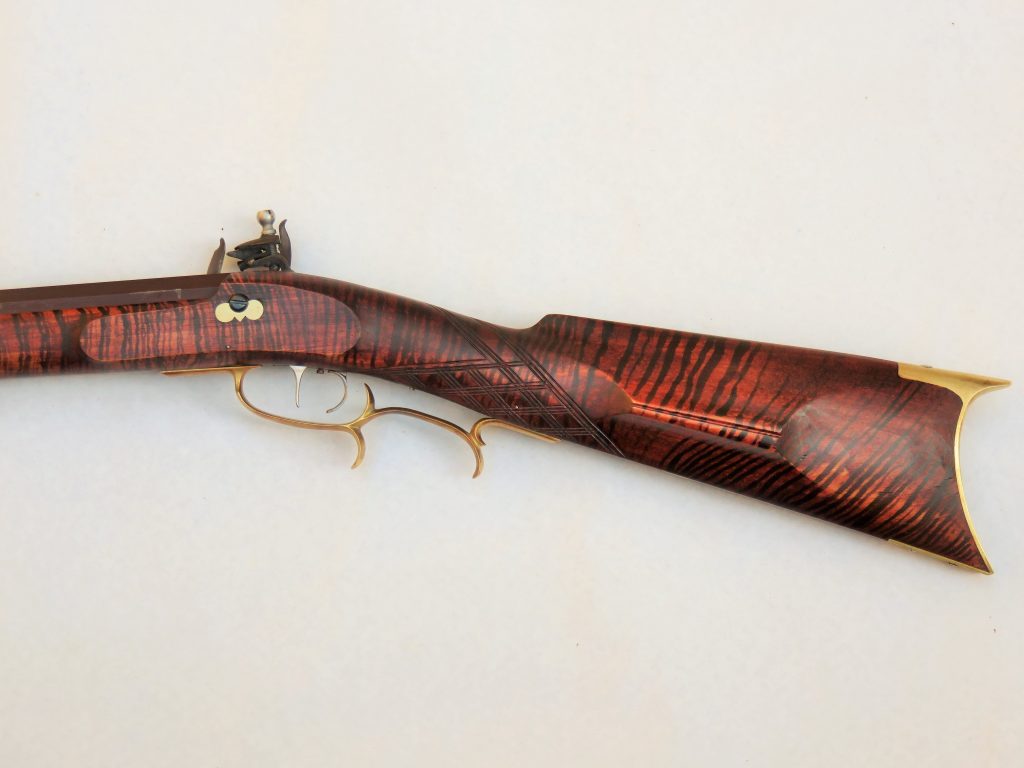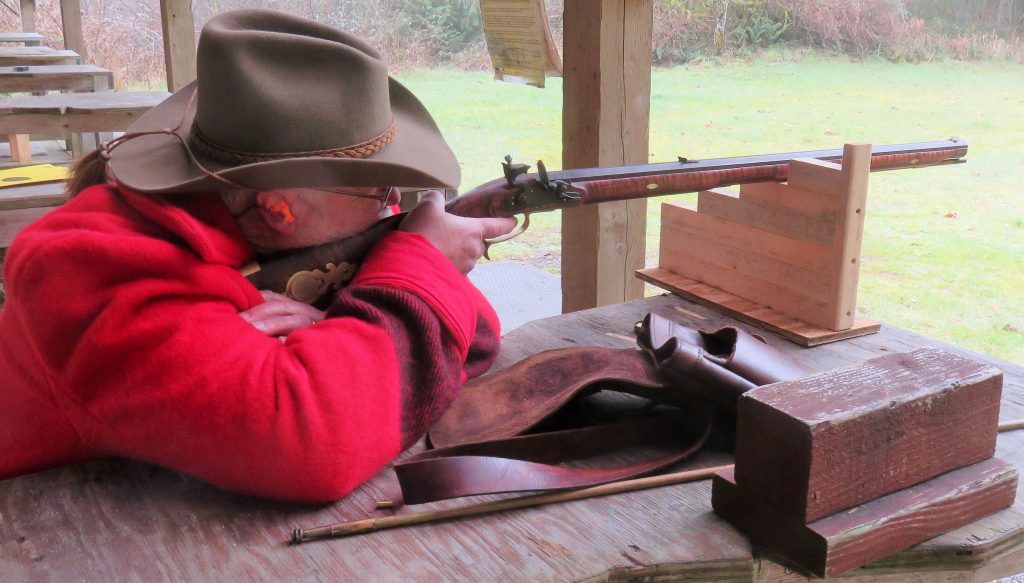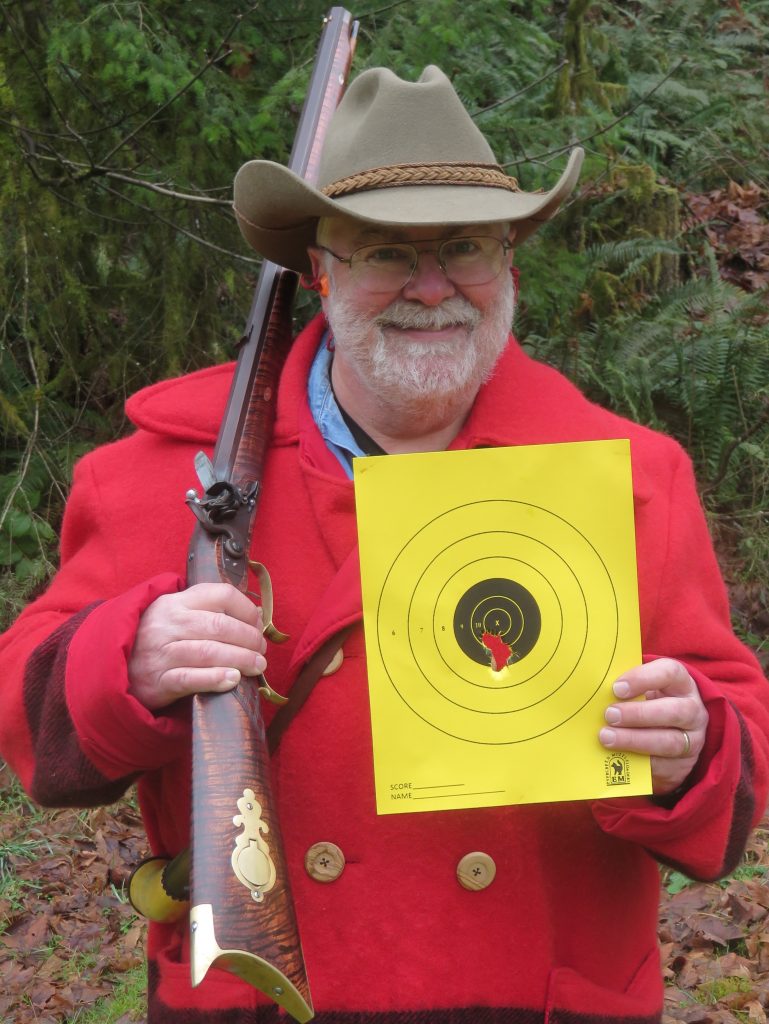
By Mike Nesbitt
This TVM Leman kit was built from one of their “Builder’s Kits” rather than the “TVM Kit” like the 20-gauge Fowler that was built and reviewed some months ago.
Getting the Builder’s Kit means a lot more work for the maker along with a savings of several dollars. While building this kit, some pieces were added that TVM does not generally provide. Also, this kit included the new excellent flint-lock from Rice.
A general break-down or description of the Builder’s Kit will include the stock which is hand-shaped to about 75% with the barrel and ramrod channels already cut. All other shaping and fitting, plus the wood and metal finishing, is left to the buyer to complete. For most of us that’s a lot of work and several tools are required. TVM recommends their Builder’s Kits to experienced or advanced gunmakers. One nice advantage to getting the Builder’s Kit is that they can usually be delivered within two to five weeks.

While the Builder’s Kits are available for several styles of muzzleloaders, there are few options available but one of them is the grade of wood for the stock. Once again, the wood selected for this gun was very plain maple because the stock would be artificially striped, like the old Leman rifles. Other options might include a difference lock, a tapered or swamped barrel, and other possible additions which, of course, add to the price of the kit.
This kit was for a .50 caliber Leman “trade rifle” style with a 1” wide barrel that was 34 inches long. (A 34-inch barrel is not a TVM standard but they happened to have one on hand, a Rice barrel in fact.) For this rifle no options were added from TVM but some parts were ordered from Track of the Wolf which were used to personalize this rifle as well as to make it more authentic. Those parts included the Leman nose cap and a trigger guard plus some nickel silver escutcheons as well as the brass Leman-style cap box. Home-made sights were also added to this rifle before it was completed.

Work began on this Builder’s Kit almost as soon as it arrived with Allen Cunniff doing most of the work. I had volunteered to do certain jobs involved with the assembly of this rifle but each time I talked with Allen about when to do my share of the task, he’d tell me it was already done. One specific duty that he did save for me was the artificial striping and that I was pleased to do. Shortly after the striping was done, using dark brown Lincoln’s leather dye with a very narrow brush, and the protective finish was applied, this rifle was ready for shooting.
Sighting-in followed along very quickly with a loading that Allen selected and has stayed with because of no reason to change it. That load used 60 grains of GOEX 3Fg powder under a .490” swaged ball wrapped in a .015” lubed patch. A snappy load, for sure. For shooting at gongs along a trail walk at various distances this almost flat shooting load requires nothing more than a dead-on hold for good hits.
Shooting with this new rifle was going very well although in a somewhat relaxed format. Allen used the rifle to shoot on the trail-walk at February’s “Rain-de-voo” and did a good job, after a slightly shaky start before he knapped a very sharp edge on the flint. But he did get an award, a pound of black powder, for his shooting and that was certainly the first shooting award earned by this new rifle.
Later we went to our favorite shooting range where we set a target out at just 25 yards because that was the distance used for initially sighting-in this new rifle. We also agreed that Allen would do the shooting, mainly because he has younger eyes, and I mentioned to him that my hope was to get a very good target to use in a photo along with this story. Allen gave me the “thumbs up” sign and prepared to do the shooting from the bench.
The load used was the same as already described, 60 grains of 3Fg, and so far I don’t know if any other loading has even been tried. We might say that going to another load would be too much like fixing something that wasn’t broken.

Allen did the shooting and he quickly went to work on a 5-shot target that was more than worthy. We could plainly see the group without going forward from the firing line. All five shots were touching in the small black bullseye on the yellow target. Measuring that group across its widest point shows just 1 ¼” and if we subtract one bullet diameter, or ½”, to get a center-to-center group measurement we’ll call that a ¾” group. Yes, that was done at only 25 yards but we had to start somewhere and that still shows excellent consistency in everything including the ignition, the load, the barrel, and most certainly the sight picture.
Then it was my turn to take some shots. The shots I took were taken offhand, first at a paper target posted at 25 yards and then at some hanging gongs which were 100 yards away. Let me suggest that my shooting on the gongs was my best, I never missed. I didn’t miss the paper target either but then Allen took over again and fired a dandy 3-shot group offhand at another paper target and his group beat mine. Actually, Allen’s 3-shot group that he fired offhanded was almost as tight as the 5-shot group he fired from the bench. Then Allen “followed my trail” by sending some bullets down range to the hanging gongs, without a miss as far as I recall.
The shooting had been very good. And it might have been even better if we had any previous experience with this new lock. I say that just because a flint-lock seems to have a break-in period, maybe that’s the time it takes for the shooter to get used to a new lock and for the lock to get used to a new shooter. Flint-locks have individual character, for sure…

Now that the shooting and field testing of this new rifle with the new Rice lock is over with, I find myself considering what else we might have done. For one thing, we might have modified the lock plate to remove the “tail” and make it look like a later period lock. That would be easy to do and that’s something to keep in mind, maybe to be done next time.
Getting one of these Builder’s Kits or the new Rice lock isn’t hard at all but the only place to get them of is from Tennessee Valley Muzzleloading. The Builder’s Kits have a base price of $700 and the new Rice locks are priced at $225 plus shipping. While these locks are being produced by the Rice brothers, TVM is the exclusive distributor for them. Orders can be placed at Tennessee Valley Muzzleloading, 1 Assembly Street, Natchez, Mississippi 39120, or call them at 601-445-5482. Even faster is to send them a note by email through their web site which is www.tvmnatchez.com.



